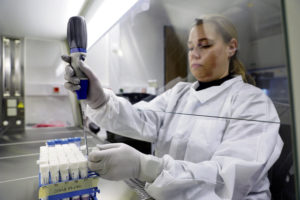
The arrival of the COVID-19 vaccine paves the way for a phased vaccine distribution plan to protect our military communities overseas against COVID-19, but that does not mean that surveillance testing becomes irrelevant.
Public Health Command Europe’s Laboratory Sciences division continues to test service members and civilians with their families who are moving to Europe, as well as service members on their way to a deployment or training, in order to determine the prevalence and infection rates of troops.
“With the surveillance testing program, we ensure critical missions can be performed, such as personnel deploying or going into a training environment,” said Nina Gruhn, a senior microbiologist and program manager at Public Health Command Europe. “Our results also allow service members, civilians and families to PCS (permanent change of station) without jeopardizing the health and wellbeing of others.”
PHCE recently passed the mark of 100K of processed COVID-19 surveillance samples. Since May 2020, PHCE has been performing COVID-19 surveillance testing for Army, Air Force and Navy personnel throughout the U.S. European Command, with additional support to U.S. Forces in U.S. Central Command.
The laboratory science division can process upwards of 2,000 samples per day using high throughput polymerase chain reaction methods developed by the PHCE lab, according to Col. Jeremy Bearss, PHCE’s Laboratory Director.
“PHCE was the first public health lab in the Army doing this type of testing,” said Gruhn. “And since then other laboratories across the military implemented the testing method as well.”
PHCE’s laboratory is an ISO 17025 accredited full-service public health laboratory, which provides biological and chemical analytical services, such as testing for bacterial contamination in food and water or heavy metals, like lead, and pesticides in water, air or soil.
For more information, follow “Public Health Command Europe” on Facebook.


